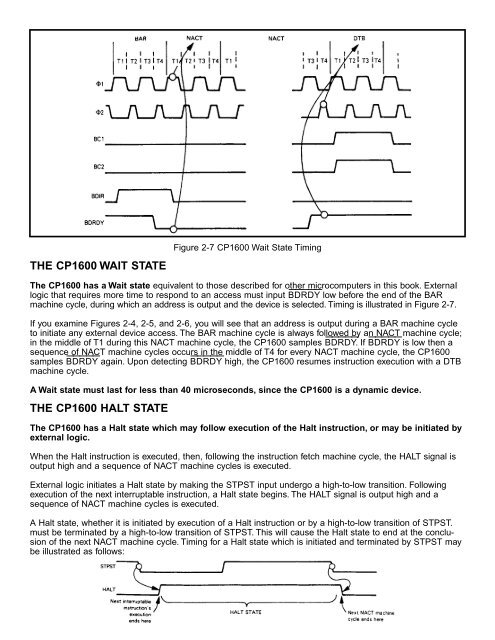Chapter 2 THE GENERAL INSTRUMENT CP1600 - Intellivision Brasil
Chapter 2 THE GENERAL INSTRUMENT CP1600 - Intellivision Brasil
Chapter 2 THE GENERAL INSTRUMENT CP1600 - Intellivision Brasil
You also want an ePaper? Increase the reach of your titles
YUMPU automatically turns print PDFs into web optimized ePapers that Google loves.
<strong>THE</strong> <strong>CP1600</strong> WAIT STATE<br />
Figure 2-7 <strong>CP1600</strong> Wait State Timing<br />
The <strong>CP1600</strong> has a Wait state equivalent to those described for other microcomputers in this book. ExternaI<br />
logic that requires more time to respond to an access must input BDRDY low before the end of the BAR<br />
machine cycle, during which an address is output and the device is selected. Timing is illustrated in Figure 2-7.<br />
If you examine Figures 2-4, 2-5, and 2-6, you will see that an address is output during a BAR machine cycle<br />
to initiate any external device access. The BAR machine cycle is always followed by an NACT machine cycle;<br />
in the middle of T1 during this NACT machine cycle, the <strong>CP1600</strong> samples BDRDY. If BDRDY is low then a<br />
sequence of NACT machine cycles occurs in the middle of T4 for every NACT machine cycle, the <strong>CP1600</strong><br />
samples BDRDY again. Upon detecting BDRDY high, the <strong>CP1600</strong> resumes instruction execution with a DTB<br />
machine cycle.<br />
A Wait state must last for less than 40 microseconds, since the <strong>CP1600</strong> is a dynamic device.<br />
<strong>THE</strong> <strong>CP1600</strong> HALT STATE<br />
The <strong>CP1600</strong> has a Halt state which may follow execution of the Halt instruction, or may be initiated by<br />
external logic.<br />
When the Halt instruction is executed, then, following the instruction fetch machine cycle, the HALT signal is<br />
output high and a sequence of NACT machine cycles is executed.<br />
External logic initiates a Halt state by making the STPST input undergo a high-to-low transition. Following<br />
execution of the next interruptable instruction, a Halt state begins. The HALT signal is output high and a<br />
sequence of NACT machine cycles is executed.<br />
A Halt state, whether it is initiated by execution of a Halt instruction or by a high-to-low transition of STPST.<br />
must be terminated by a high-to-low transition of STPST. This will cause the Halt state to end at the conclusion<br />
of the next NACT machine cycle. Timing for a Halt state which is initiated and terminated by STPST may<br />
be illustrated as follows:


